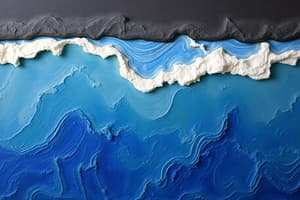Podcast
Questions and Answers
What is another name for the oceanic relief?
What is another name for the oceanic relief?
Sea relief, underwater relief or ocean floor
What is the continental shelf?
What is the continental shelf?
The region of the ocean floor closest to the coast.
What are the depth ranges of the continental shelf?
What are the depth ranges of the continental shelf?
Between 0 and 200 meters below the sea surface.
What are the terms used to describe the continental shelf, slope and rise collectively?
What are the terms used to describe the continental shelf, slope and rise collectively?
What is an underwater basin?
What is an underwater basin?
What are abyssal plains?
What are abyssal plains?
What are ocean trenches?
What are ocean trenches?
What are oceanic ridges?
What are oceanic ridges?
What are seamounts?
What are seamounts?
Flashcards
Continental Shelf
Continental Shelf
The submerged extension of a continent, sloping gently from the shoreline to a depth of about 200 meters. It's a rich ecosystem for marine life.
Continental Slope
Continental Slope
A steep incline that marks the transition between the continental shelf and the deep ocean floor. It can have depths ranging from 3,000 to 4,000 meters.
Continental Rise
Continental Rise
A gently sloped area at the base of the continental slope, formed by sediments deposited over time. It acts as a transition zone between the continental margin and the abyssal plain.
Continental Margin
Continental Margin
Signup and view all the flashcards
Underwater Basins
Underwater Basins
Signup and view all the flashcards
Abyssal Plains
Abyssal Plains
Signup and view all the flashcards
Ocean Trenches
Ocean Trenches
Signup and view all the flashcards
Oceanic Ridges
Oceanic Ridges
Signup and view all the flashcards
Seamounts
Seamounts
Signup and view all the flashcards
Spreading Centers
Spreading Centers
Signup and view all the flashcards
Subduction
Subduction
Signup and view all the flashcards
Convergent Plate Boundaries
Convergent Plate Boundaries
Signup and view all the flashcards
Divergent Plate Boundaries
Divergent Plate Boundaries
Signup and view all the flashcards
Transform Plate Boundaries
Transform Plate Boundaries
Signup and view all the flashcards
Plate Tectonics
Plate Tectonics
Signup and view all the flashcards
Igneous Rock
Igneous Rock
Signup and view all the flashcards
Sedimentary Rock
Sedimentary Rock
Signup and view all the flashcards
Metamorphic Rock
Metamorphic Rock
Signup and view all the flashcards
Erosion
Erosion
Signup and view all the flashcards
Weathering
Weathering
Signup and view all the flashcards
Transportation
Transportation
Signup and view all the flashcards
Deposition
Deposition
Signup and view all the flashcards
Organic Rock
Organic Rock
Signup and view all the flashcards
Bioweathering
Bioweathering
Signup and view all the flashcards
Regolith
Regolith
Signup and view all the flashcards
Geomorphological Processes
Geomorphological Processes
Signup and view all the flashcards
Floodplain
Floodplain
Signup and view all the flashcards
Clastic Sedimentary Rock
Clastic Sedimentary Rock
Signup and view all the flashcards
Chemical Sedimentary Rock
Chemical Sedimentary Rock
Signup and view all the flashcards
Organic Sedimentary Rock
Organic Sedimentary Rock
Signup and view all the flashcards
Study Notes
Oceanic Relief
- Defined as sea relief, underwater relief, or ocean floor
- Various formations within oceanic relief include:
Continental Shelf
- Region closest to the coast, a flat extension
- Gradual increase in depth away from the coast
- Depth ranges between 0 and 200 meters below the sea surface
- High concentration of marine plant and animal life
Continental Slope
- Sharp decline or descent from the continental shelf
- Depth range between 3000 and 4000 meters
- Zone of sediment precipitation, controlled by gravity
Continental Rise
- Gradual transition to the abyssal plain
- Filled with sediment
- Includes continental shelf, slope, and rise; collectively known as the continental margin
Submarine Canyons
- Deep valleys carved into the continental slope
- Often originate on land and continue into the sea
- Formed by erosion, often by rivers
Seamounts
- Volcanic hills on the ocean floor
- Can reach elevations up to 1000 meters above the seafloor
Oceanic Ridges
- Formed by the spreading apart of tectonic plates
- Magma rises to create new crust
- Areas of volcanic and seismic activity
Abyssal Plains
- Extensive flat areas on the ocean floor
- Formed by sediments from continents
- Very deep part of the ocean
Ocean Trenches
- Deep, narrow depressions
- Tectonic plates collide (one subducts under another), creating trenches
- Areas of seismic activity
- Also known as oceanic trenches or simply as trench
Studying That Suits You
Use AI to generate personalized quizzes and flashcards to suit your learning preferences.




